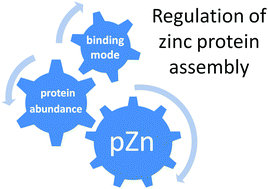当前位置:
X-MOL 学术
›
Metallomics
›
论文详情
Our official English website, www.x-mol.net, welcomes your feedback! (Note: you will need to create a separate account there.)
Interdependence of free zinc changes and protein complex assembly – insights into zinc signal regulation†
Metallomics ( IF 3.4 ) Pub Date : 2017-12-14 00:00:00 , DOI: 10.1039/c7mt00301c Anna Kocyła 1, 2, 3, 4, 5 , Justyna Adamczyk 1, 2, 3, 4, 5 , Artur Krężel 1, 2, 3, 4, 5
Metallomics ( IF 3.4 ) Pub Date : 2017-12-14 00:00:00 , DOI: 10.1039/c7mt00301c Anna Kocyła 1, 2, 3, 4, 5 , Justyna Adamczyk 1, 2, 3, 4, 5 , Artur Krężel 1, 2, 3, 4, 5
Affiliation

|
Cellular zinc (Zn(II)) is bound with proteins that are part of the proteomes of all domains of life. It is mostly utilized as a catalytic or structural protein cofactor, which results in a vast number of binding architectures. The Zn(II) ion is also important for the formation of transient protein complexes with a Zn(II)-dependent quaternary structure that is formed upon cellular zinc signals. The mechanisms by which proteins associate with and dissociate from Zn(II) and the connection with cellular Zn(II) changes remain incompletely understood. In this study, we aimed to examine how zinc protein domains with various Zn(II)-binding architectures are formed under free Zn(II) concentration changes and how formation of the Zn(II)-dependent assemblies is related to the protein concentration and reactivity. To accomplish these goals we chose four zinc domains with different Zn(II)-to-protein binding stoichiometries: classical zinc finger (ZnP), LIM domain (Zn2P), zinc hook (ZnP2) and zinc clasp (ZnP1P2) folds. Our research demonstrated a lack of changes in the saturation level of intraprotein zinc binding sites, despite various peptide concentrations, while homo- and heterodimers indicated a concentration-dependent tendency. In other words, at a certain free Zn(II) concentration, the fraction of a formed dimeric complex increases or decreases with subunit concentration changes. Secondly, even small or local changes in free Zn(II) may significantly affect protein saturation depending on its architecture, function and subcellular concentration. In our paper, we indicate the importance of interdependence of free Zn(II) availability and protein subunit concentrations for cellular zinc signal regulation.
中文翻译:

游离锌变化和蛋白质复合物组装的相互依赖性–锌信号调节的见解†
细胞锌(Zn(II))与蛋白质结合,蛋白质是生命所有域蛋白质组的一部分。它主要用作催化或结构蛋白辅因子,可产生大量的结合结构。Zn(II)离子对于形成具有瞬态蛋白质复合物也很重要,该复合物具有随细胞锌信号形成的依赖Zn(II)的四级结构。蛋白质与Zn(II)缔合和解离以及与细胞Zn(II)变化的联系的机制仍未完全了解。在这项研究中,我们旨在研究在游离Zn()下如何形成具有各种Zn(II)结合结构的锌蛋白结构域。II)浓度变化以及依赖于Zn(II)的装配体的形成与蛋白质浓度和反应性之间的关系。为了实现这些目标,我们选择了四个具有不同Zn(II)-蛋白质结合化学计量比的锌域:经典锌指(ZnP),LIM域(Zn 2 P),锌钩(ZnP 2)和锌钩环(ZnP 1 P 2)折叠。我们的研究表明,尽管存在各种肽浓度,蛋白内锌结合位点的饱和度水平也没有变化,而同二聚体和异二聚体则显示出浓度依赖性的趋势。换句话说,在一定的自由Zn(II浓度),形成的二聚体复合物的分数随亚基浓度的变化而增加或减少。其次,取决于其结构,功能和亚细胞浓度,即使游离锌(II)的微小变化或局部变化也可能显着影响蛋白质饱和度。在我们的论文中,我们指出了游离锌(II)可用性和蛋白质亚基浓度相互依赖对于细胞锌信号调节的重要性。
更新日期:2017-12-14
中文翻译:

游离锌变化和蛋白质复合物组装的相互依赖性–锌信号调节的见解†
细胞锌(Zn(II))与蛋白质结合,蛋白质是生命所有域蛋白质组的一部分。它主要用作催化或结构蛋白辅因子,可产生大量的结合结构。Zn(II)离子对于形成具有瞬态蛋白质复合物也很重要,该复合物具有随细胞锌信号形成的依赖Zn(II)的四级结构。蛋白质与Zn(II)缔合和解离以及与细胞Zn(II)变化的联系的机制仍未完全了解。在这项研究中,我们旨在研究在游离Zn()下如何形成具有各种Zn(II)结合结构的锌蛋白结构域。II)浓度变化以及依赖于Zn(II)的装配体的形成与蛋白质浓度和反应性之间的关系。为了实现这些目标,我们选择了四个具有不同Zn(II)-蛋白质结合化学计量比的锌域:经典锌指(ZnP),LIM域(Zn 2 P),锌钩(ZnP 2)和锌钩环(ZnP 1 P 2)折叠。我们的研究表明,尽管存在各种肽浓度,蛋白内锌结合位点的饱和度水平也没有变化,而同二聚体和异二聚体则显示出浓度依赖性的趋势。换句话说,在一定的自由Zn(II浓度),形成的二聚体复合物的分数随亚基浓度的变化而增加或减少。其次,取决于其结构,功能和亚细胞浓度,即使游离锌(II)的微小变化或局部变化也可能显着影响蛋白质饱和度。在我们的论文中,我们指出了游离锌(II)可用性和蛋白质亚基浓度相互依赖对于细胞锌信号调节的重要性。



























 京公网安备 11010802027423号
京公网安备 11010802027423号